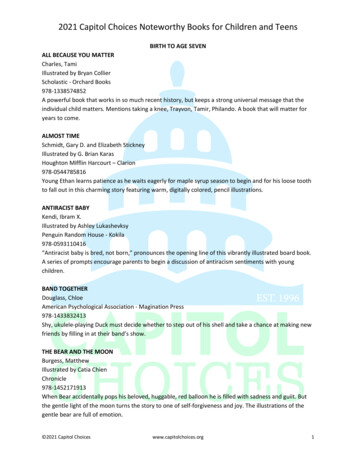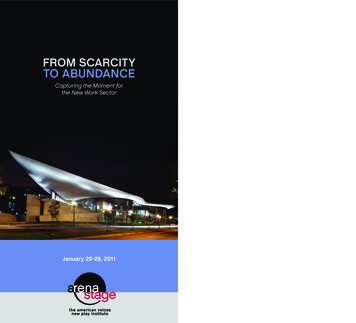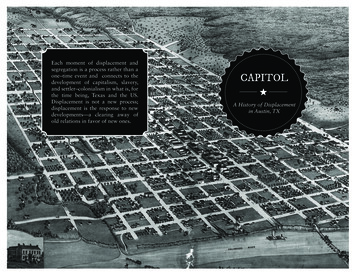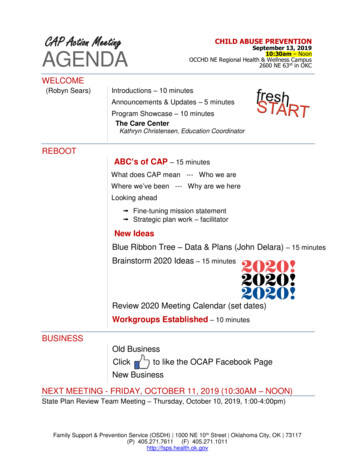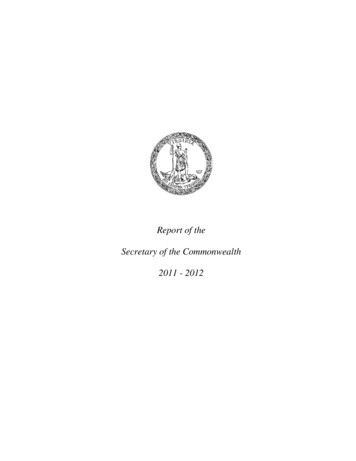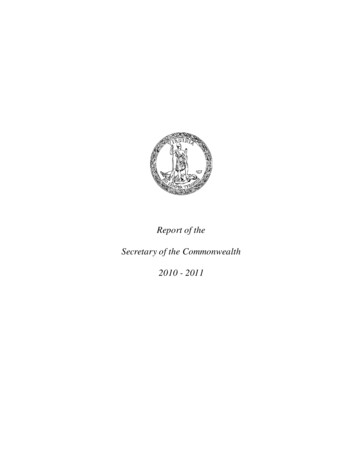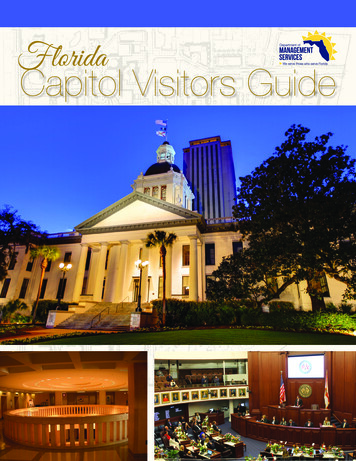
Transcription
FloridaCapitol Visitors Guide Prepared on behalf of the Capitol Center Planning CommissionPrepared by The Architects Collaborative Inc., Cambridge, Massachusetts
Table of ContentsWelcome!. 1History of the Capitol. 2About the Construction. 3Design Notes. 4The Capitol Complex. 5The Capitol Welcome Center. 6Self-Guided Tours. 6Tour Requirements. 6Touring the Historic Capitol. 7Entrance and Exit Procedures. 7Tours During Legislative Session. 7Viewing the Legislative Session. 7Decorum. 8The Plaza Level. 9Weissenborn Plaque. 10“Images of the Sunshine State” Murals. 11Cason Memorial Stairwell. 11Permanent and Temporary Art Exhibits. 11The Florida House of Representatives. 12The Florida Senate. 12The Cabinet Meeting Room. 12The Observation Deck. 13North View. 13West View. 13South View. 13East View. 13Capitol Information. 14Times of Operation. 14State Holidays Closed. 14Scheduling Events at the Capitol. 14Access and Accessibility. 14Restrooms and Water Fountains. 14Access to Legislature. 14Requirements for Entry. 15Capitol Gift Shop. 15Capitol Complex Map. 16Parking. 16Visitor Parking. 16Capitol Loading Zone. 16Downtown Map. 17
Welcome!Thank you for planning a visit to Florida’s Capitol, the center of Florida’s government. This iswhere many decisions are made about how to make Florida a thriving and successful place forFlorida’s families and businesses.The Capitol Complex and museums in the downtown Tallahassee area offer a wealth of historyand insight into Florida’s government and history.Guided and self-guided tours are available, but whichever you choose, make sure you allowplenty of time for your visit. Please take a moment to review decorum guidelines (page 8) thatvisitors should follow during tours.This Florida Capitol Visitors Guide provides information that will help you get the most out ofyour visit. The Capitol has a diverse legacy that is inspiring, and often amusing, and we hopeyou enjoy exploring and learning about Florida’s government. Prepared on behalf of the Capitol Center Planning CommissionPrepared by The Architects Collaborative Inc., Cambridge, MassachusettsFlorida1Capitol Visitors Guide
History of the CapitolFlorida’s Capitol building has a rich ancestry, which began in 1824 with the establishment ofTallahassee as the capital city. As Florida’s population continues to grow, so has its need forgovernment services. The Capitol symbolizes the growth and development of Florida. TheCapitol Complex, located in downtown Tallahassee, is the headquarters for state government.The Capitol is a 22-story building and is home to Florida’s executive and legislative branches.Other buildings at the Capitol Complex include the two four-story office buildings for the Houseof Representatives and Senate as well as the Historic Capitol and the Knott Building.The Capitol is located in downtown Tallahassee at the intersection of Apalachee Parkway andMonroe Street. The Capitol is open to the public Monday through Friday, 8 a.m. to 5 p.m. andis closed on weekends and holidays. Prepared on behalf of the Capitol Center Planning CommissionPrepared by The Architects Collaborative Inc., Cambridge, MassachusettsFlorida2Capitol Visitors Guide
About the ConstructionThe current Capitol is the fourth buildingto serve as Florida’s Capitol building. Thefirst Capitol was a log cabin built in 1824with the establishment of Tallahassee as thestate’s territorial capital. In 1826, a two-storyframe structure replaced the first Capitol.The construction of the third Capitol startedin 1839 and was completed by 1845. ThisCapitol was expanded four times. There hasbeen debate about relocating the Capitol toanother area of the state. In 1900, relocationwas placed on the ballot, but it was voteddown.In 1969, the Governor and the Cabinetapproved the plans for a new Capitol whenit was determined the previous Capitol couldno longer accommodate state governmentand legislators. Debate on relocationresurfaced in the early 1970’s. Relocationnever made it to the ballot, but it waspassionately debated nonetheless.The architects and engineers for the currentCapitol were Edward Durell Stone of New Yorkonandbehalfthe firmof Reynolds,Smith,and CommissionPreparedof theCapitol CenterPlanningHills byof TheJacksonville.Insteadof the traditionalPreparedArchitectsCollaborativeInc., Cambridge, Massachusettsbrick and column, a design reflective ofmodern Florida was chosen. The currentCapitol complex reflects the New Classicismstyle.Edward Durell Stone, ArchitectFlorida3Capitol Visitors Guide
Design NotesThree other state capitolsuse the same tower design(Louisiana, Nebraska, andNorth Dakota). Constructionof the Capitol began onNovember 8, 1973, and wasdeclared completed on August19, 1977. To ensure that therewould be no “mortgage”on this new building, the 43,070,741 price tag was paidbefore the first cornerstonewas laid. An additional 1,957,338 was committedto landscaping the west frontarea known as Waller Park.The park is named after JudgeCurtis L. Waller of the UnitedStates Circuit Court of Appeals.Upon the Capitol’s completion,restoration on the HistoricCapitol began. The Historic Capitol was refurbished to thePreparedonitbehalfCapitolCenter Planning Commissionwaylookedofinthe1902.HerschelPreparedby The aArchitectsCollaborative Inc.,Cambridge,MassachusettsHowlong didit take to build the Capitol?Shepard,restorationarchitect, was quoted asConstruction on the Capitol begansaying, “The Old Capitol willNovember 8, 1973. The Capitol wasbe like a jewel worn by theNew.” The Historic Capitol isdeclared completed on August 19, 1977.now called the Florida HistoricTotal work time was 1,016 days, requiringCapitol Museum.more than 3,200,000 hours of labor.Florida4Capitol Visitors Guide
The Capitol ComplexThe Capitol Complex is home to five buildings: the Capitol, the House and Senate office buildings, the Knott Building,and the Historic CapitolMuseum. The Capitolhas been located inTallahassee since 1824.To allow emergencyvehicles access to thebuildings and to keepthe building historicallyaccurate, the north,south, east, and westwings were removed, andthe dome was added backwhen the Historic Capitolunderwent restorationfrom 1978-1982. Thisintroduced Floridians tothe 1902 version of thebuilding when it openedas the Historic CapitolMuseum.The House and Senateoffice buildings arelocated on north andsouth ends of theCourtyard, respectively.The House Office Buildingis four-stories high andis located on the north end of the Courtyard. ThePreparedonandbehalfof the Capitol Center Planning Commissionsecondthird floorsPreparedby ThethatArchitectshave bridgesconnect Collaborative Inc., Cambridge, Massachusettsthe Capitol and office buildings. The Complex features a variety of memorials and monuments dedicated to Florida’s history.The Senate Office Building is four stories high and is located on the south end of the Capitol Complex. The second, third,and fourth floors have bridges that connect to the Capitol and office buildings.The Knott Building is named for Comptroller and Treasurer William V. Knott. Originally built by the City of Tallahassee in1940, the State of Florida purchased the building in 1951. In 1999, a skywalk was added to connect the newly renovatedKnott Building to the Capitol.Waller Park is located on the west side of the Capitol. “Stormsong,” a sculpture of a pod of dolphins in the Florida HeritageFountain that is the centerpiece of Waller Park, was added in 2003.Florida5Capitol Visitors Guide
The Capitol Welcome CenterPlease contact the Capitol Welcome Center at 850-488-6167 for holiday hours and tours. TheWelcome Center is open Monday through Friday, 8 a.m. to 5 p.m.Self-Guided Tours Each tour must have at least 15 people and no morethan 50, including chaperones.Self-guided tours of the Capitol can be taken Mondaythrough Friday between 8 a.m. and 5 p.m., excluding anyweekday holidays. School groups must provide one chaperone for every10 children.Pick up a self-guided tour sheet at the Capitol WelcomeCenter. The tour begins in the Courtyard between theHistoric Capitol and Capitol. Guided tours are available for 4th grade students orhigher. Tour times are Monday through Friday at 9 a.m., 10a.m., 11 a.m., 1 p.m., and 2 p.m.Large group tours: Be sure to check ahead for availabilityfor weekday guided tours. Tours cannot be scheduled on Saturdays, Sundays, orstate holidays. For groups of 45 or more, consider dividing yourgroup in half and send half to the Capitol and half tothe Historic Capitol and then switch after each tour. You must inform the Welcome Center whenever anychanges are made to your group. Tours of the Capitol generally last 45-60 minutes. You will need to providethe following groupPrepared on behalf of the Capitol Center Planning Commissioninformation when scheduling your tour:TourbyRequirementsPreparedThe Architects Collaborative Inc., Cambridge, Massachusetts Name of group or school; Tours are scheduled on a first-come, first-served basis.Scheduling of a tour does not guarantee that a guidewill be available. Age and/or grade level; When the tour guide is unavailable information forself-guided tours can be made available. Contact person(s) with contact number(s) andemail address(es) (if available); Size of the group; Groups do not need to schedule a tour to visit theCapitol. However, it is strongly recommended thatthey inform the Welcome Center of their intention tovisit. This assures that the visiting group will be awareof all security policies. Preferred date and time (alternate dates or timesshould be kept in mind if primary date or time isalready booked); and Any special needs of the group. The best time for school groups (especially grades 4-7)to visit the Capitol is when the Legislature is not insession.Florida6Capitol Visitors Guide
Touring the Historic CapitolViewing the Legislative SessionIf you or a group wishes to observe the Legislature, hereare some guidelines:Entrance and Exit ProceduresVisitor access is either from the west (near the FloridaHeritage Fountain) or the east. The Historic Capitol canbe entered using the handicap entrance located on thenorth side of the West Portico. Gallery seating is limited, and availability is dependentupon the length of the daily session and the numberof visitors seeking admittance. Group leaders who wish to visit the viewing gallery ofthe House or Senate chambers should inform the staffoutside the galleries and notify them of the numberof students in their group. It may be necessary to waitbefore entering.For information about security requirements for entry,see page 15.Tours During Legislative SessionTours during this time should be made several months inmost groupsare allowed 15 minutes to Once inside, advance.observe the lawmakers in action.Prepared on behalf of the Capitol Center Planning CommissionTour reservations for a legislative session will be takenPrepared by The Architects Collaborative Inc., Cambridge,Massachusetts Studentsshould be reminded that important statebeginning August 1 of the preceding year, as tours arenot scheduled more than six months in advance. A sevendays’ notice is required to schedule a tour.business is being conducted in each chamber. All visitors of the galleries must remain seated andquiet and may not applaud. All phones and electronic devices must be turned offbefore entering gallery. Leaning over the gallery railing from the first row isprohibited. Flash photography is not allowed in the gallery. The schedule of legislative meetings for the Senateand the House of Representatives is continuallyupdated during session and is available online.Florida7Capitol Visitors Guide
Decorum When visiting the Capitol, it is important toremember that it is a working building. To ensure apleasant and safe visit, please advise your group tobe respectful of the Welcome Center staff, Capitolstaff, and other visitors. Students should not run in the Capitol public areas,hallways, or stairwells, nor should they lean over anybalcony railing. To minimize hallway and stairwellcongestion, stay to the right and in single file. Food, gum, beverages, and the use of electronicdevices such as earphones or cellular telephones arenot permitted while on tour. Be respectful of the Capitol and Welcome Centerproperty by not touching furnishings, paintings, orstatues. Take a restroom break before your scheduled tourtime begins. Restrooms are located on each floor ofthe Capitol. No storage is available for groups to leavebelongings, lunches, ice chests, etc. Plans should bemade for the retrieval of these items from outsidethe Capitol. Teachers and adult supervisors are responsiblefor the discipline and safety of their studentsthroughout the tour. Cameras are allowed in the Capitol tour area;however, visitors are not allowed to use a flash in achamber viewing gallery area. When moving around the Capitol, please do soin a quiet and orderly fashion. All conversationshould be kept at whisper level. Excess noise androwdiness could result in termination of the tourand a request to leave the Capitol. Certain areas will have limited access at times andsecurity procedures may be modified from time totime. Prepared on behalf of the Capitol Center Planning CommissionPrepared by The Architects Collaborative Inc., Cambridge, MassachusettsFlorida8Capitol Visitors Guide
portraits of former Florida governors. The Governor’sreception area is open to the public. Beyond thereception area, behind secured doors, is the Governor’sOffice. The Lieutenant Governor also has an officehere, and this is where the Governor’s meeting roomis located. Members of the Cabinet also have officeslocated on the plaza level. The Attorney General’s Officesits in the south wing with the Governor’s Office. Thenorth wing houses offices of the Commissioner ofAgriculture and Chief Financial Officer.Governor Requirements The Governor is elected to afour-year term and can serve a maximum of two terms.To serve as Governor, a person has to be at least 30 yearsold and must have been a Florida resident for at leastthe last seven years. These requirements apply to theLieutenant Governor and Cabinet members as well. TheAttorney General must also have been a member of theFlorida Bar for the last five years.The Plaza LevelThe Great Seal of the State of Florida is located on theeast side of the Plaza Level inside the Capitol. This areais known as the Rotunda. This is the seal that was in usewhen the building was dedicated. The diameter of thedisplay is 10 feet, with the state seal being eight feetacross and each small seal measuring three feet across.Surrounding the Rotunda are various halls of fame andwalls of honor.The Florida Women’s Hall of Fame was created in 1982by the Governor’s Commission on the Status of Women.In 1994, the permanent display in the northwest cornerof the Rotunda was unveiled. Each person inducted has aplaque with her photo and biography.The Fallen Firefighters Wall of Honor lists firefighterskilled in the line of duty. The Florida Veterans’ Hall of Fame recognizes military veteransmadesignificantcontributionto thePreparedon whobehalfofatheCapitolCenter PlanningCommissionState byof Floridaduring or aftertheir military service.PreparedThe ArchitectsCollaborativeInc., Cambridge, MassachusettsThe Florida Civil Rights Hall of Fame is dedicated tothose who contributed to the struggle for equality andjustice for all.Congressional Medal of Honor Plaques displaybiographies of the recipients.The Florida Artists Hall of Fame displaysplaques with an image of the inductees and theirbiographies.The Executive Office of the Governor is locatedon the Plaza Level, south of the Great Seal.The corridor leading to the office is lined withFlorida9Capitol Visitors Guide
The Capitol Welcome Center is located on the West Plaza Level and is one of five official Florida welcome centers in the state. The others areon I-10 (Pensacola), U.S. 231 (Campbellton), I-75 (Jennings), and I-95 (Yulee). Florida was one of the first states to establish highway welcomecenters, with the U.S. Highway 17 Yulee Welcome Center the first to open in 1949. The official Florida welcome centers provide visitors withinformation relating to travel, highways, sports, climate, resort areas, cities, outdoor recreation, and attractions.The Heritage ChapelWeissenborn PlaqueAccording to section 5 of Senate Bill 678 (passed May 29,Florida is one of only1978), a plaque shall be placed in the lobby of the Capitola few statehousesand shall be inscribed as follows: “This plaque is dedicatedthat have a chapel. Ato Senator Lee Weissenborn whose valiant effort to movespecial commissionthe Capitol to Orlando was the prime motivation for theconverted the areaconstruction of this building.” This plaque is the result ofinto the chapel, usingconflicts over the Historic Capitol restoration. Senator Jackspecial donations.Gordon of Miami Beach added the above section to the bill,Upon completion inand House members supporting the restoration kept the1980, the chapel wassection.officially dedicatedThey did notas a meditationwant to sendroom. Unlike the rest of the building, which uses Italianit back tomarble in the public areas, materials in the chapel arethe Senatefrom Florida. The walls are made of coquina cast from theand haveit beaches between Jacksonville and St. Augustine. The ceilingdie, so thePreparedon behalfthe ofCapitolCenterCommissionand entrywaywalls areofmadetidewatercypressPlanningthatbill passed.was submergedin theApalachicolaRiver for moreInc.,than Cambridge,Preparedby TheArchitectsCollaborativeMassachusettsFormer50 years before reclamation. Both the fountain and theSenatortable are made of keystone from a quarry in Florida City.KennethThe painting on the back wall is called “Creation” and wasPlante, at themade by Florida artist Jean Welsh to symboliz “the mysteryrequest ofof ordering ourselves, through God, out of the chaos ofSenator Gordon, provided the plaque. The plaque was affixeda natural world.” The painting was set up to be viewed into the north center wall of the Plaza Level in 1982.conjunction with the door. The spheres embedded in thedoor are made of glass that washed onto Florida’s shores.The plaques on the walls trace Florida’s religious heritagefrom the prehistoric Indians to the present day.Florida10 Capitol Visitors Guide
“Images of the Sunshine State” MuralsArtist James Rosenquist created the two “Images of the Sunshine State” murals in 1978. The murals represent variousrecreational activities and industries in Florida. The left mural uses the cosmic background to symbolize space travel andthe Kennedy Space Center. The scuba diver and woman in the pool represent Florida’s “aquatic fun in the sun” activities.The pine tree above the Great Seal represents north Florida’s lumber, pulp, and paper industries. In the lower right corneris a palmetto scrub, a ubiquitous Florida bush.The mural on the right represents the flora and fauna of Florida, the Mockingbird, Florida cattle ranchers, ocean life, lakes,and the Everglades.Cason Memorial StairwellOwen “Casey” Cason served as a law enforcement officer for Florida for 52 years. He regularly jogged stairwell numbernine for exercise. After his death in 1992, Governor Lawton Chiles and the Cabinet declared that stairwell number ninewould henceforth be known as the Captain Owen “Casey” Cason Memorial Stairwell.Permanent and Temporary Art ExhibitsThe Capitol has both permanent and temporaryart displays. On the lower floors of the Capitol and legislativePrepared on behalf of the Capitol Center Planning Commissionoffice buildings are photographs from Florida’sPrepared by The Architects Collaborative Inc., Cambridge, Massachusettshistory. These images from Florida’s PhotographicArchives are on permanent display. They werechosen and placed by the Florida LegislativeResearch Center.The rotating display areas at the Capitol Complexinclude the 22nd Floor Capitol Gallery, the CabinetMeeting Room, and the gallery at the HistoricCapitol. The Capitol Gallery is managed by theFlorida Department of State’s Division of CulturalAffairs, which maintains an exhibition calendar.Florida11 Capitol Visitors Guide
The Florida House of RepresentativesThe Florida House of Representatives has 120members. The Speaker of the House decides the seatingarrangement in this chamber.The House Chamber underwent a major renovation in1999, from modern to Victorian. During the renovation,the bulletproof glass separating the chamber floor fromthe viewing galleries was removed. Metal detectorsand guard stations are used for screening. A first-come,first-served seating arrangement is used for the galleries,though the House may occasionally reserve a section.A faux alabaster and glass chandelier hangs over thechamber, and the dark-colored wood used throughoutthe chamber is mahogany. Surrounding the chamberfloor are portraits of former Speakers of the House, andat the head of the center walkway is a color rendition ofthe seal of the House of Representatives. The filming ofthe floor debate is done with the help of eight roboticcameras operated by The Florida Channel. A stadiumstyle TV screen is located on the back wall above theSpeaker’s level. The screen can be used to show thetext of any bill or amendment, video presentations, orlive transmission of the floor debate. On each side ofthe screen are voting boards. When a vote is cast, eachrepresentative’s vote is displayed on the boards.The Florida SenateThe Florida Senate has 40 members. The members fromeven-numbered districts sit on one side of the chamberwhile members from odd-numbered districts sit on theother.Following the adjournment of the 2016 LegislativeSession, the Senate Chamber, built in 1978, underwent ahistoric renovation. Prior to the renovation, only minimalupdates, including those necessary to accommodatechanges in technology, had been made since theoriginal construction. The renovated Senate Chamberincorporates several historical elements as well as newfeatures designed to improve accessibility for peoplewith unique abilities.The viewing galleries of the Senate are open areas.Visitors must pass through metal detectors and a guardstation to enter the galleries. The galleries operate ona first-come, first-served basis, though a senator mayoccasionally reserve a section.The chamber ceiling is designed to reflect sound to thecenter of the room. This design enables senators tobe heard throughout the chamber when speaking in anormal tone of voice. However, the senators still usetheir microphones for recording purposes and so thatpeople in the hallways can hear them. There are fourbuttons on each senator’s desk and function the sameway as the buttons on the desks of representatives.Each desk has three buttons located under thenameplate on the desk. The number on the nameplateindicates the representative’s district number. The redThe paintings that surround the Senate Chamber areand green buttons are for voting. When a representativeportraits of former presidents of the Senate datingneeds an errand performed, the yellow button is pressedback more than 100 years. The glassed-in area aboveto summon a House page or messenger. There are a the the Senate entrance is formedia. The areas in theof lightsthat CommissionPrepared on behalf of the CapitolseriesCenterPlanningbalconies with the black metal posts are where thecan be seenInc.,only Cambridge,televisioncameras are mounted. The Florida ChannelPrepared by The Architects CollaborativeMassachusettswhen seated at thefilms the Senate when they are in chambers.representative’sdesk. One lightThe Cabinet Meeting Roomgoes on when thatThe Cabinet Meeting Room is located on the Lowerrepresentative’sLevel. At least monthly, a meeting is held between themicrophone isGovernor and the Cabinet. This is a meeting with alive. Another lightset agenda and is open to the public. Currently, thereindicates that the Speaker would like to see thatare three cabinet posts: the Attorney General, therepresentative up front. The next two lights deal with theCommissioner of Agriculture, and the Chief Financialdesk phone. Each representative has a phone attachedOfficer. Florida’s Cabinet members are elected to a fourto the underside of the desk that conne
Florida 4 Capitol Visitors Guide Design Notes Three other state capitols use the same tower design (Louisiana, Nebraska, and North Dakota). Construction of the Capitol began on November 8, 1973, and was declared completed on August 19, 1977. To ensure that there would be no "mortgage" on this new building, the 43,070,741 price tag was paid

